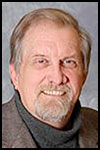Dr. Marvin McMillen: Music as medicine

A hard-working young man somewhere in Yamhill County has a few too many beers on a Friday night. He runs his pickup off the road into a tree at 50 mph. He survives, but breaks his shoulder, his collarbone, five or six ribs. He punctures a hole in a bruised lung, and has a “minor” concussion visible on a head CT scan.
In the hospital, his pain is managed with a combination of drugs: Tylenol-like, aspirin or Motrin-like, opiates, and drugs, which prolong the opiate pain relief effect without making the patient “high.” Anesthesiologists decide whether to perform a “nerve block” or give the patient patches of anesthetics or low dose fentanyl.
After a week in the hospital, the man transitions to outpatient care, taking Tylenol, Motrin, Neurontin and oxycodone for another week. By about the fifth week after his injury, his pain is managed solely with Tylenol and Motrin, plus an occasional oxycodone when the weather is cold and wet. He is nearly painfree after six months, but has missed several months of work. He embraces a full recovery physically to his state of health before his injury, which is recorded in a Trauma Center’s records as “moderate to severe” with a successful outcome. But what will be the long-term consequences of his injury?
These kind of tragedies occur too frequently. And when they do, the unknown enduring effects can be much more damaging than the injuries caused from the crash. Today, some medical institutions are embracing music as an integral aspect of the recovery process from the beginning.
But first, back to our crash victim:
The first or second week home, he is likely to be highly frustrated and upset. He will be surprised and frightened by how weak the uninjured part of his body is. He is also likely to feel overwhelmed by the immediate loss of income: The USDOT report suggests his average missed wages for that three to six months will be somewhere between $20,000 and $70,000. Thirty-four percent of Americans have no savings account whatsoever, and another 35 percent have less than $1,000 in their savings account. He and his young family are certain to be highly stressed by a financial deficit of that magnitude, even in states with good health insurance like Oregon and Massachusetts.
In the early phases of his illness, he will face uncertainty of recovery and often difficulty sleeping even though he’s fatigued. But as he increasingly dreads the complex other issues caused by his injury, there are many more reasons to lie awake at night. He is experiencing a dramatic loss of both physical and personal power, unlike anything he’s likely to have encountered previously. One in six marriages will not survive the trauma and consequences of his injury.
In the course of his medical recovery, he experienced pain and agitation, and perhaps even “ICU psychosis,” to which is now added anxiety about his recovery, depression about his weakness and deconditioning, uncertainty about his work and financial affairs, loneliness and abandonment, anger and frustration. The more depressed and upset he becomes, the less likely he is to participate in rehabilitation and exercise, worsening the weakness and further slowing recovery. If he tells most well-meaning physicians or surgeons about his difficulties, they may readily prescribe Ambien for sleep, Xanax for anxiety and oxycodone for his pain. But in truth, these physicians’ best intentions may represent a serious component of how his initial injury introduces him to an ongoing problem with opiate addiction. Much of his frustration is that he has lost power, and depending on a physician’s prescriptions only compounds the problem.
Assessing pain is amazingly hard for physicians, and one’s own personal injuries are often helpful in learning how long pain lasts, and the benefits and side effects of pain relievers. It is actually surprising to see what good painkillers Tylenol-like drugs, aspirin or Motrin-like drugs really are. Tylenol-like drugs are now being administered intravenously post-operatively for pain control and work well. A test called functional magnetic resonance imaging is now allowing us to measure the actual chemicals by which our brain works, and how both emotion and drugs affect them. fMRI has permitted increased understanding of how drugs and the brain work, but perhaps the major surprise has been the demonstration of just how powerful music is on brain function.
Music turns on six times the brain activity of speech, and activates parts of the brain controlling heart rate, blood pressure and other basic body functions. It can make your hair stand on end (even at low volume).
In 2015, researchers in the United Kingdom examined all 4,621 English language studies on music and pain control for surgery and injury. They chose the best-designed 73 studies — involving 6,902 patients — and found music significantly reduced the need for pain and sedation in surgical patients by 20 to 54 percent. The authors concluded: “Music is a non-invasive and inexpensive intervention that can be delivered easily and successfully in the hospital setting.”
We have worked with recorded music, music videos, music therapists and medically trained musicians in intensive care, surgery and trauma units now for 15 years. The idea is somewhat more complex than it sounds at first blush — musicians must be really, really good, versatile, with a large and flexible repertoire, know how to connect with the patient and family, and leave their egos at the door. We also think including them into the team of doctors, nurses and physicians’ assistants increases the success of the program, which requires at last 50 hours of education in basic medicine and surgical issues. Once the medical musician has worked with patient and family to identify the music that best helps them relax and cope, we are training volunteers to teach them the technology of streaming online radio applications and other downloads on their iPhones to reinforce the process following discharge.
To this end, we created the first “Medicine for Musicians” course taught by the medical faculty of Berkshire Medical Center in Massachusetts this July. Our goal is to find recording level guitarists and keyboardists, usually with some personal experience of serious illness or critical care. They must be willing to devote a summer’s week to learn more about medicine and the patient and family experience of illness, and then volunteer at least two hours a day, two days a week, for a year as real members of the intensive care unit team. Our efforts have been encouraged by other intensive care unit doctors and trauma surgeons who have contacted us about the program.
The goal is to train musicians capable of playing for very sick patients and family; musicians who have a broad and varied repertoire to help patients find “the right musical prescription.” The process is then reinforced with downloads and Pandora algorithms to create “safe musical spaces” to confront and deal with the patient’s pain, anxieties and frustrations as they recover.
Berkshire Medical Center will be offering the program to musicians for the second time the last week of July 2018. We would welcome inquiries from other doctors and physicians who might be interested in extending the program to their practices.
As the opioid epidemic begins to kill more patients in the United States than automobile accidents, we must explore every available modality to enhance the patient’s ability to reclaim autonomy in their life in the pain control and recovery process. Developing a personal ritual for pain and anxiety that includes non-addictive painkillers and “the right musical prescription” may be an effective and empowering modality.










Comments